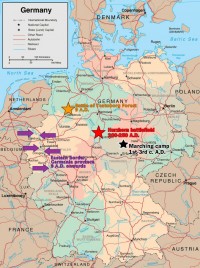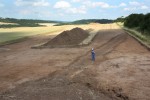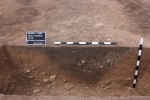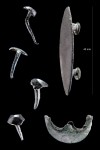 A Roman marching camp from the 1st to 3rd century A.D. has been discovered near the town of Hachelbich in Thuringia. It’s the first Roman military camp found in the eastern German province and the first camp that is more than a day’s travel from the eastern border of the empire on the Rhine. In fact, it’s closer to the Elbe River than it is to the Rhine (the Elbe is about 150 miles east of the site, the Rhine 220 west), a strong indication that the Roman military did not completely withdraw to the Rhine even after three legions led by Publius Quintilius Varus were slaughtered by Germanic tribesmen at the Battle of Teutoburg Forest in 9 A.D.
A Roman marching camp from the 1st to 3rd century A.D. has been discovered near the town of Hachelbich in Thuringia. It’s the first Roman military camp found in the eastern German province and the first camp that is more than a day’s travel from the eastern border of the empire on the Rhine. In fact, it’s closer to the Elbe River than it is to the Rhine (the Elbe is about 150 miles east of the site, the Rhine 220 west), a strong indication that the Roman military did not completely withdraw to the Rhine even after three legions led by Publius Quintilius Varus were slaughtered by Germanic tribesmen at the Battle of Teutoburg Forest in 9 A.D.
 The discovery of a large third century battlefield on Harzhorn hill in Lower Saxony in 2008 confirmed that there was a significant Roman military presence east of the Teutoburg Forest more than 200 years after Varus’ humiliating defeat. Archaeologists estimate about 1,000 Roman soldiers fought (and won) at Harzhorn. The Hachelbich marching camp is about 60 miles southeast of Harzhorn. It covers 18 hectares and was large enough to accommodate an entire legion of around 5,000 soldiers. As a marching camp, it wasn’t a permanent fortress, but rather a protective enclosure built by the legionaries in one evening so they could camp down in a defended position. They wouldn’t have spent more than a few days there while on their way elsewhere, in this case probably east towards the Elbe.
The discovery of a large third century battlefield on Harzhorn hill in Lower Saxony in 2008 confirmed that there was a significant Roman military presence east of the Teutoburg Forest more than 200 years after Varus’ humiliating defeat. Archaeologists estimate about 1,000 Roman soldiers fought (and won) at Harzhorn. The Hachelbich marching camp is about 60 miles southeast of Harzhorn. It covers 18 hectares and was large enough to accommodate an entire legion of around 5,000 soldiers. As a marching camp, it wasn’t a permanent fortress, but rather a protective enclosure built by the legionaries in one evening so they could camp down in a defended position. They wouldn’t have spent more than a few days there while on their way elsewhere, in this case probably east towards the Elbe.
 The site was found in 2010 during road work, but it was kept quiet while archaeologists explored the area. They excavated more than two hectares and covered another 10 hectares with magnetometers and aerial surveys. Now that the site has been identified as a military camp, the Thuringian State Office for Heritage and Archaeology has announced the find. They’re keeping the exact location a secret, however, to keep looters from ravaging the place on the hunt for portable Roman artifacts.
The site was found in 2010 during road work, but it was kept quiet while archaeologists explored the area. They excavated more than two hectares and covered another 10 hectares with magnetometers and aerial surveys. Now that the site has been identified as a military camp, the Thuringian State Office for Heritage and Archaeology has announced the find. They’re keeping the exact location a secret, however, to keep looters from ravaging the place on the hunt for portable Roman artifacts.
A rough rectangle with round corners, the camp is standard Roman military issue. No matter where they were, legions on the move set up a minifortress in the wilderness at the end of each day’s march. At Hachelbich, the meter-deep trenches dug around the camp were the easiest feature to spot in the soil. Two perimeter trenches have been found, each more than 400 meters long.
On the camp’s northern edge, the soldiers built a gate protected by another trench that projected out past the perimeter. “It’s typically Roman—no Germans did that sort of thing,” Kuessner says. The trenches were part of a simple, but effective makeshift perimeter defense: A low wall of dirt was thrown up behind the trench, then topped with tall stakes, to create a defensive barrier almost 3 meters wide and 3 meters high. Erosion wiped away the wall long ago, but it left discolorations in the soil where the trench was dug.
 Archaeologists also unearthed the remains of eight bread ovens close to the camp perimeter, which shows an impressive commitment to quality food considering the legionaries weren’t going to be there for long. Some artifacts confirming the military nature of the camp were found: four hobnails from the soles of Roman caligae, fittings from a sword scabbard and horse tackle.
Archaeologists also unearthed the remains of eight bread ovens close to the camp perimeter, which shows an impressive commitment to quality food considering the legionaries weren’t going to be there for long. Some artifacts confirming the military nature of the camp were found: four hobnails from the soles of Roman caligae, fittings from a sword scabbard and horse tackle.
 The style of the artifacts places the camp in the first two centuries of the first millennium and radiocarbon dating supports the range, but archaeologists haven’t found anything to narrow it down any further or link to the camp to the reign of a certain emperor. Excavations will continue this year and the next at least. After the crops in the valley are harvested this fall, archaeologists will be able to excavate the farmland. They hope to find coins that will provide a precise date, or an artifact with the legion number on it that would write a new chapter in Roman military history.
The style of the artifacts places the camp in the first two centuries of the first millennium and radiocarbon dating supports the range, but archaeologists haven’t found anything to narrow it down any further or link to the camp to the reign of a certain emperor. Excavations will continue this year and the next at least. After the crops in the valley are harvested this fall, archaeologists will be able to excavate the farmland. They hope to find coins that will provide a precise date, or an artifact with the legion number on it that would write a new chapter in Roman military history.